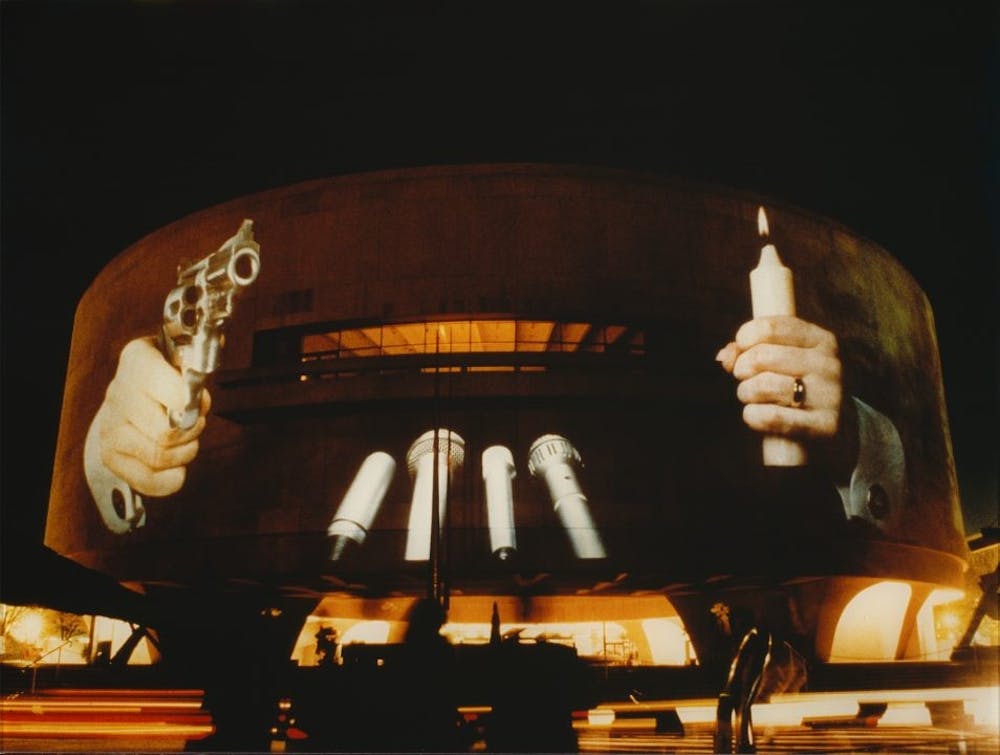The Hirshhorn Museum and Sculpture Garden restaged a projection by Krzysztof Wodiczko titled “Hirshhorn Museum, Washington, D.C.” on Feb. 13, 30 years after it was first displayed in 1988.
Wodiczko’s work is an outdoor projection first displayed on the wall of the Hirshhorn’s iconic circular building as a part of the museum’s “WORKS” program, which focused on temporary exhibitions designed specifically for display in the museum and its sculpture garden. The projection features two hands, one holding a gun, the other a candle, with several microphones in between. The microphones are indicative of a press conference.
Wodiczko originally created the projection to comment on the media’s controlling influence on the 1988 presidential election and political debates over reproductive rights and the death penalty.
Throughout his career, Wodiczko has projected images onto the faces of public buildings and monuments, believing that his art could raise public awareness of social issues.
“There is a society of wounded people that must be addressed rather than overlooked,” Wodiczko told Art Journal in 2003. “And I believe that I must be an agent who can contribute to this process of change.”
This theme also influenced the Hirshhorn’s new exhibition “Brand New: Art and Commodity in the 1980s,” which features work from Jeff Koons, Andy Warhol, Erika Rothenberg and other artists who explore the intersection of commercial advertising and art.
“He Kills Me” (1987) by Donald Moffett, a poster originally designed for use in protests of the federal government’s inaction during the AIDS epidemic of the late 1980s, exemplifies this theme. The poster features an image of a smiling Ronald Reagan and the words “He Kills Me” in a simple, blocky font. Moffett uses bold colors, an aesthetic reminiscent of contemporary advertising, to make the poster attractive to the public. The brightness of the design is a stark contrast to its message.
At the event on Feb. 13, while the restaging was still on display, the Hirshhorn also hosted an artist talk with Wodiczko and the Guerrilla Girls, a group of feminist activist artists who have worked to raise awareness of institutional sexism and racism, particularly within the world of art.
The Guerrilla Girls’ work is also a part of the “Brand New” exhibition. “These galleries show no more than 10% women artists or none at all” (1985) is a simple black-and-white image that lists art galleries which do as the title suggests.
Following the school shooting in Parkland, Florida on Feb. 14, the Hirshhorn decided to suspend the restaging of Wodiczko’s projection, which was intended to run until Feb. 15.
In a recent press release, Hirshhorn Director Melissa Chiu said, “Now is a time for mourning and reflection, and out of sensitivity to our community in D.C. and beyond, the Hirshhorn, Smithsonian leadership and artist Krzysztof Wodiczko have made the decision to postpone the artist’s projection.”
Wodiczko also provided his own response, saying,“To me, the silence feels most respectful. In this case, not showing the projection shows respect and sensitivity to the people who suffer from this great tragedy.”
The Hirshhorn plans to restage “Hirshhorn Museum, Washington, D.C.” on an unspecified future date. “Brand New: Art and Commodity in the 1980s” will be on display until May 13.





